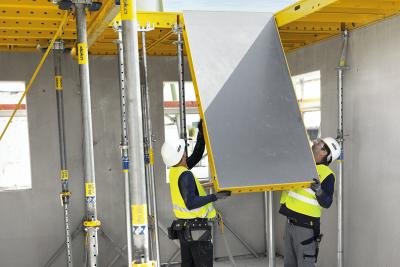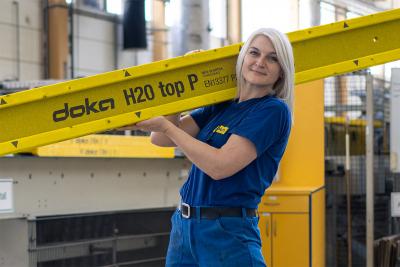"A growing competitive factor."
In an interview with Julia Weber, Head of Sustainability at Doka, we look at the growing importance of carbon footprints and their profound implications for construction companies seeking to achieve ambitious sustainability goals.

What is Doka's aim in terms of sustainability?
Julia Weber (JW): At Doka, we strive to be a driving force for sustainable practices within the construction industry. We want to lead by example which is why we have set ourselves an ambitious goal: to achieve net zero emissions by 2040. As part of an industry that makes a significant impact on the climate, accounting for around 37 percent of global greenhouse gas (GHG) emissions, we have a responsibility to be part of the solution. We also strongly believe that sustainability is key to future business opportunities. Therefore, we aim to make a positive impact on the environment by supporting our customers in achieving their own sustainability goals, rather than just reducing negative impact on the environment from our own business activities.

Doka aims to make a positive impact on the environment by supporting their customers in achieving their own sustainability goals
How does Doka concrete support its customers in this respect?
JW: There are many factors that go into the choice of formwork – panel sizes, weight and much more. But what about the carbon footprint of a product? More and more construction projects are demanding transparency about associated greenhouse gas emissions. At Doka, we not only supply formwork and scaffolding solutions, we are also pioneering the way by providing our customers with an insight into the greenhouse gas emissions of more than 7,000 Doka products over the relevant life cycle phases.
Can you explain this in more detail?
JW: We share the Product Carbon Footprint (PCF) data with our customers on request. This allows them to compare the carbon footprints of our products to make informed and environmentally responsible decisions. They can choose the products with the lower carbon footprint to improve their own carbon balance.

“Sustainability is a strategic advantage in the long term, and we are already seeing the first results in the market due to our status as a front runner.”
How does this data contribute to your customers' sustainability goals?
JW: The EU aims to be climate-neutral by 2050 – an economy with net-zero greenhouse gas emissions. This target was made mandatory with the adoption of the EU Green Deal and affects the economies and industries of its member states. European companies will need to calculate and report their greenhouse gas emissions over the next few years. We also note that public tenders are increasingly demanding transparent data on emissions, making it a growing competitive factor. Our customers, both in and outside of Europe, are setting ambitious, science-based sustainability goals today. So, it is essential that we work closely together throughout the entire supply chain. They rely on their suppliers to help them calculate their Scope 3 emissions, which in our case would be the PCF data.
European companies rely on their suppliers to help them calculate their Scope 3 emissions, which in our case would be the product carbon footprint (PCF) data.

Does Doka also use the data also for internal purposes?
JW: Absolutely! By calculating the PCF, we increase the transparency of our GHG hotspots over the entire lifecycle of all our products. This enables us to identify the potential for reducing greenhouse gas emissions and adopt targeted actions across our entire value chain. Our mission is to design sustainable products from the ground up, actively contributing to our goal of net zero by 2040.
Do you have any questions on the article? Get in touch with us!